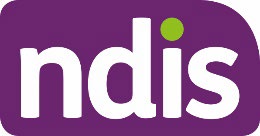 Research paper
Research paper
FOI 24/25-0223
Document 1
OFFICIAL
For Internal Use Only
Therapy for chronic incomplete cervical spinal
cord injury
The content of this document is OFFICIAL.
Please note:
The research and literature reviews collated by our TAB Research Team are not to be shared
external to the Branch. These are for internal TAB use only and are intended to assist our
advisors with their reasonable and necessary decision-making.
Delegates have access to a wide variety of comprehensive guidance material. If Delegates
require further information on access or planning matters, they are to call the TAPS line for
advice.
The Research Team are unable to ensure that the information listed below provides an
accurate & up-to-date snapshot of these matters
Research question: For adults living with a high-level Spinal Cord Injury at least 5+ years
post-injury, how does the provision of a high level of physiotherapy and/or occupational
therapy hours for the purpose of restoring upper limb function, compared to reduced therapy
hours and a delegated model of care, impact functional upper limb outcomes?
Date: 13/6/24
Requestor: s47F - personal privacy
Endorsed by: Helen Bs47F - personal privacy
Researcher: Aaron Hs47F - personal priva
Cleared by: Aaron Hs47F - personal priva
1. Contents
Therapy for chronic incomplete cervical spinal cord injury ......................................................... 1
1. Contents .......................................................................................................................... 1
2. Summary ......................................................................................................................... 2
3. Improving function for chronic spinal cord injury.............................................................. 2
4. Therapy targeting upper limb function ............................................................................. 2
5. References ...................................................................................................................... 5
Therapy for SCI
Page 1 of 6
OFFICIAL
Page 1 of 6
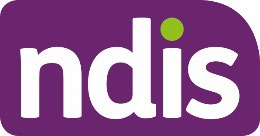
FOI 24/25-0223
Research paper
Document 1
OFFICIAL
For Internal Use Only
2. Summary
There is some evidence that therapy continues to be effective in improving upper limb function
and strength for people in the chronic stage of cervical spinal cord injury. Conventional
physiotherapy or occupational therapy focussing on hand and arm function is possibly effective
in this cohort and participants may be benefited by conventional training combined with robot-
assisted upper limb training and/or electrical stimulation. It may be more likely that benefit
could be achieved for people with incomplete rather than complete injury.
However, the level of evidence reviewed is generally low to very low certainty. Insufficient
evidence was found to determine optimal frequency or timing to achieve the possible benefits
for upper limb function and strength. Insufficient evidence was found to determine whether
gains were likely to be achieved after 5 years.
No studies were found investigating the efficacy of a delegated model of care for the people
with chronic cervical spinal cord injury.
3. Improving function for chronic spinal cord injury
The chronic phase of spinal cord injury is usually defined as starting from 12 months post-
injury and represents a period during which the neurological function of the person stabilises.
Some sources indicate that functional gains can stil be made up to 2 years post-injury and
possibly longer in the case of incomplete injury (Spinal Cord Injury Guidelines, 2022; Willig et
al, 2022; Kalsi-Ryan et al, 2021). Therapy and management during this phase wil often focus
on adaptive skil -building and preventing secondary complications (contracture, pressure
sores, inactivity, weight gain, decline in strength and fitness) (Spinal Cord Injury Guidelines,
2022; Kalsi-Ryan et al, 2021).
Some evidence shows that functional outcomes may be improved during the chronic stage of
spinal cord injury. Chiou et al (2022) found moderate quality evidence that arm-crank exercise
could improve cardiorespiratory fitness in people with chronic spinal cord injury. However, the
study does not differentiate effect for higher and lower levels of injury. A review from Figoni et
al (2021) that looks specifically at those with higher level injuries found inconclusive evidence
aerobic exercise could improve fitness for people with tetraplegia.
4. Therapy targeting upper limb function
Reviews analysing evidence into the effectiveness of therapies for improvement of upper limb
function for people with people with chronic spinal cord injury have generally showed positive
results from very low certainty evidence. One review found exercise interventions were able to
improve upper extremity motor control and functional ability in people with chronic cervical
spinal cord injury (Kloosterman et al, 2009). The authors noted good methodological quality in
the included studies. However, later reviews tend to find positive results from very low certainty
evidence. Lu et al (2014) found evidence that improvements in upper limb function and
Therapy for SCI
Page 2 of 6
OFFICIAL
Page 2 of 6
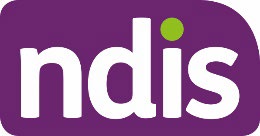
FOI 24/25-0223
Research paper
Document 1
OFFICIAL
For Internal Use Only
strength was possible for people in the chronic stage of spinal cord injury. While they note that
the internal validity of the studies was fair to good, the external validity was generally poor.
The
Australian and New Zealand Clinical Practice Guidelines for the physiotherapy
management of people with Spinal Cord Injury evaluate the evidence and clinical consensus
surrounding physiotherapy management strategies for people with spinal cord injury (Glinsky
et al, 2022). As of 2022, none of the management strategies that the authors identified were
supported by good quality evidence, though many achieved high levels of clinical endorsement
(refer to Table 1).
A more recent meta-analysis of variables associated with improved function hand-arm training
programs for people with cervical spinal cord injury notes:
analysis of 8 training programmes showed that training programmes using only skil
training or combined with strength and endurance training exhibited a moderate effect
on [arm-hand skil ed performance]. Training programmes that integrate the task-oriented
training components: functional movements, clear functional goals, real-life object
manipulation, multiple movement planes, total skil practice, context-specific
environment, exercise variety, and bimanual practice demonstrated a moderate effect
on [arm-hand skil ed performance] (Bertels et al, 2023, p.9).
The authors also compared effect sizes for participants with complete and incomplete injuries,
and for sub-acute and chronic stages. While the authors suggest that the results were no
different for each group, they also note that the meta-analysis was not reported due to an
insufficient number of studies.
Bertels et al (2022) also note that a minimum of 8 weeks seems to be required to achieve
moderate effect size. However, they also note that dosage parametres are not reported
consistently and were unable to identify optimal frequency or intensity of therapy to achieve
clinically meaningful results.
Bertels et al (2022) note very low certainty evidence around robotic assisted therapy for upper
limb function. They provide a strong consensus recommendation in favour of the therapy.
More recent evidence provides inconsistent support for this recommendation. Ho et al (2023)
reviewed seven studies looking into the effectiveness of robotic-assisted upper limb
rehabilitation to improve upper limb function after cervical spinal cord injuries. Four of the
studies showed statistically significant improvements in upper limb function and strength. The
studies showing significant results in favour of the intervention (4 out of 7) were all small
sample case-series or observational studies. The only randomised control trial included in the
review did not produce a statistically significant effect.
Other recent studies have produced suggestive evidence. A 2023 observational study of 6
patients with chronic C5-7 level injury investigated the effects of the functional hand protocol.
The participants were between 30 and 90 years old. Two participants were <2 years post-
injury. The other four participants had sustained spinal cord injury between 13 and 35 years
prior (Ciardi et al, 2023). The functional hand protocol is described as:
Therapy for SCI
Page 3 of 6
OFFICIAL
Page 3 of 6
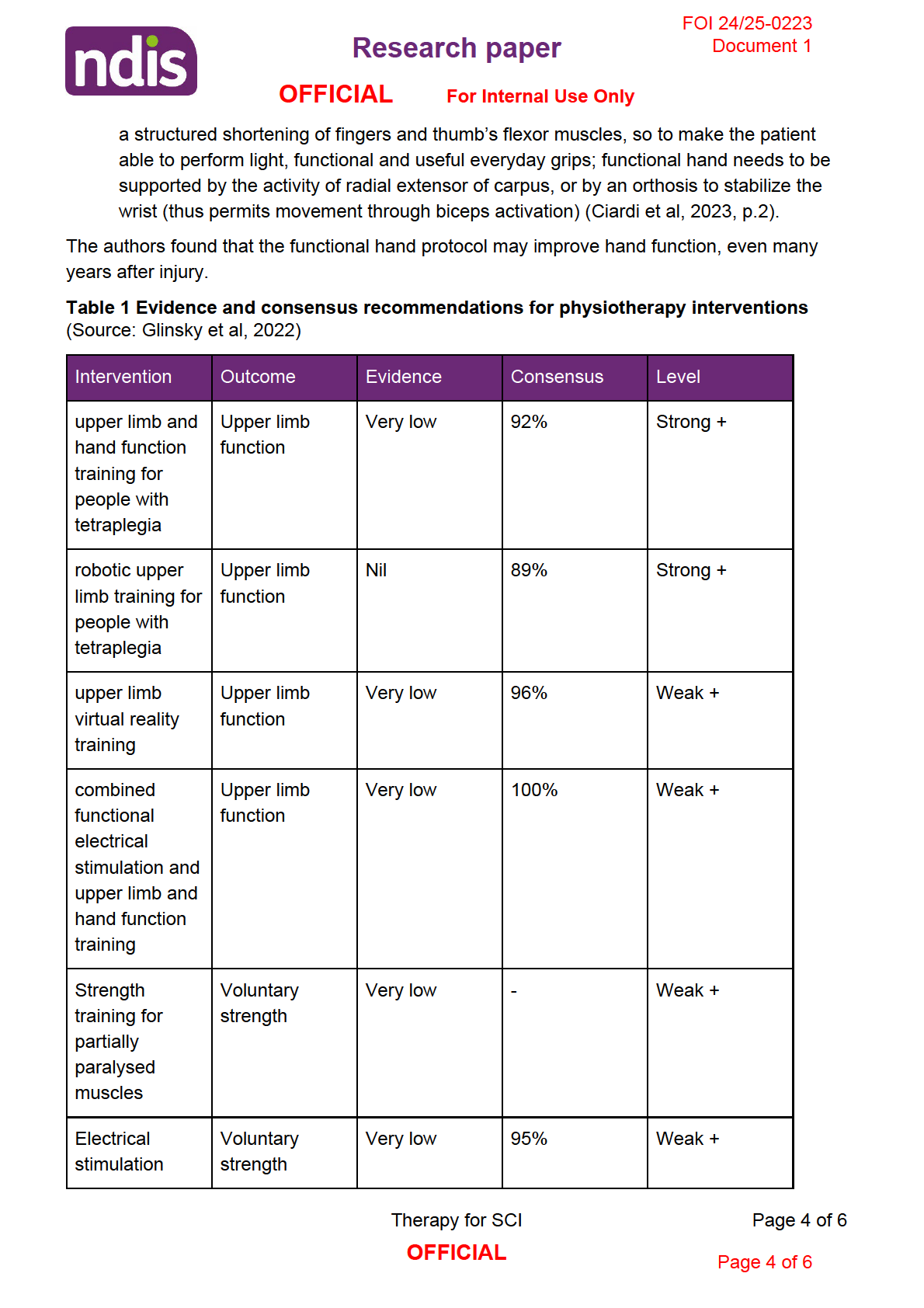
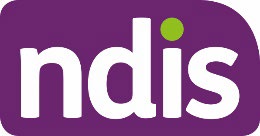
FOI 24/25-0223
Research paper
Document 1
OFFICIAL
For Internal Use Only
combined with
strength
training
Electrical
Voluntary
Very low
-
Weak -
stimulation
strength
Shoulder
Pain
Very low
81%
Strong +
exercises
5. References
Bertels, N., Seelen, H., Dembele, J., & Spooren, A. (2023). Essential training variables of arm-
hand training in people with cervical spinal cord injury: a systematic review.
Journal of
rehabilitation medicine, 55, jrm7147. https://doi.org/10.2340/jrm.v55.7147
Chiou, S. Y., Clarke, E., Lam, C., Harvey, T., & Nightingale, T. E. (2022). Effects of Arm-Crank
Exercise on Fitness and Health in Adults With Chronic Spinal Cord Injury: A Systematic
Review. Frontiers in physiology, 13, 831372. https://doi.org/10.3389/fphys.2022.831372
Ciardi, G., Lamberti, G., & Avanzi, M. (2023). Using "functional hand" protocol to improve hand
function following a spinal cord injury: an explorative study. Acta bio-medica : Atenei
Parmensis, 94(5), e2023255. https://doi.org/10.23750/abm.v94i5.14408
Ho, J. S., Ko, K. S., Law, S. W., & Man, G. C. (2023). The effectiveness of robotic-assisted
upper limb rehabilitation to improve upper limb function in patients with cervical spinal
cord injuries: a systematic literature review.
Frontiers in neurology, 14, 1126755.
https://doi.org/10.3389/fneur.2023.1126755
Figoni, S. F., Dolbow, D. R., Crawford, E. C., White, M. L., & Pattanaik, S. (2021). Does
aerobic exercise benefit persons with tetraplegia from spinal cord injury? A systematic
review. The journal of spinal cord medicine, 44(5), 690–703.
https://doi.org/10.1080/10790268.2020.1722935
Glinsky J.V., Harvey L.A. and the Australian and New Zealand Physiotherapy Clinical Practice
Guidelines consortium. (2022).
Australian and New Zealand Clinical Practice Guideline
for the physiotherapy management of people with spinal cord injury.
https://sciptguide.com/about-guidelines/documents/
Kalsi-Ryan, S., Kapadia, N., Gagnon, D. H., Verrier, M. C., Holmes, J., (NA), Flett, H.,
Farahani, F., Alavinia, S. M., Omidvar, M., Wiest, M. J., & Craven, B. C. (2021).
Development of Reaching, Grasping & Manipulation indicators to advance the quality of
spinal cord injury rehabilitation: SCI-High Project. The journal of spinal cord medicine,
44(sup1), S134–S146. https://doi.org/10.1080/10790268.2021.1961052
Therapy for SCI
Page 5 of 6
OFFICIAL
Page 5 of 6
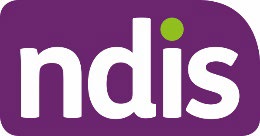
FOI 24/25-0223
Research paper
Document 1
OFFICIAL
For Internal Use Only
Kloosterman, M. G., Snoek, G. J., & Jannink, M. J. (2009). Systematic review of the effects of
exercise therapy on the upper extremity of patients with spinal-cord injury. Spinal cord,
47(3), 196–203. https://doi.org/10.1038/sc.2008.113
Lu, X., Battistuzzo, C. R., Zoghi, M., & Galea, M. P. (2015). Effects of training on upper limb
function after cervical spinal cord injury: a systematic review.
Clinical rehabilitation,
29(1), 3–13. https://doi.org/10.1177/0269215514536411
Spinal Cord Injury Clinical Guidelines. (2022). Physiopedia. https://www.physio-
pedia.com/Spinal_Cord_Injury_Clinical_Guidelines
Wil ig RM, Garcia I, da Silva NSL, Corredeira R, Carvalho J. The effectiveness of community-
based upper body exercise programs in persons with chronic paraplegia and manual
wheelchair users: A systematic review. J Spinal Cord Med. 2022 Jan;45(1):24-32. doi:
10.1080/10790268.2020.1782608. Epub 2020 Jul 9. PMID: 32644024; PMCID:
PMC8890546.
Therapy for SCI
Page 6 of 6
OFFICIAL
Page 6 of 6





